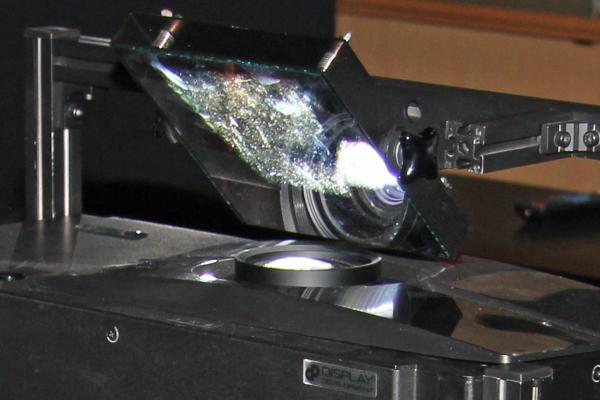Projectors for Imperfect Rooms

I’ve been covering video projection since the early 1990s, but last week was the first time I walked into a product display and had a hard time figuring out which projector was showing which picture.
In its showcase of new products last week at Stewart Filmscreen, Display Development showed that it can deliver bright projected pictures in situations that most other projection companies couldn’t cope with. Every projector was positioned at some weird angle to its screen—but every picture looked really good.
When we first encountered Display Development last year, it was a start-up seeking to deliver projected pictures as bright as the images seen on flat-panel TVs. Only a year later, it seems poised to become one of the largest players in high-end video projection — if it isn’t already.
Company co-founder Jim Burns told me that his company has taken over U.S. distribution of Projectiondesign. Projectiondesign is a Norwegian company known as an actual manufacturer (as opposed to rebrander) of high-end video projectors. Display Development will be working with projectiondesign in its development of Avielo-branded products for the residential North American market, and will continue to sell projectors bearing the Display Development brand."
The most interesting projector Burns showed was the $45,000 Display Development IW4, a vertically oriented projector designed to be installed inside a wall. The projector points straight up, and its image reflects 90 degrees off a small, adjustable mirror. All you see is a small glass port in the wall — and a big, bright, great-looking picture. If you wish, the port can be concealed, James-Bond-villain style, by a motorized, moving piece of artwork. The IW4 and the $55,000 IW3 fit into an 8.5-inch-thick wall, between 30-inch-on-center studs. Both projectors include an integral, powered ventilation system.
Burns emphasized the projectors’ dual-lamp design, which gives them a hellaciously bright picture. The IW3 is rated at 8,000 lumens, and the IW4 will come in around 6,000 lumens, he said, noting that the IW4 on display was putting out about 45 footlamberts on a 10-foot perforated screen. Compare that to about 16 footlamberts for a typical home theater projector in a dark environment.
“The customer’s reference these days isn’t a movie theater or a home theater projector, it’s a Samsung flat-panel TV,” Burns said. “Customers expect a video display to have that bright picture, and in a room where you have lights on, you need it.”
Stewart Filmscreen sales VP Joaquin Rivera agreed. “Most of our customers don’t watch movies with all the lights out,” he said. “Sometimes they’re doing other things while they watch the movie, and they may have kids running around, so they want a projector that will give them a great picture even when the lights are up a bit.”
The other projector that grabbed my eye was the Optix SuperWide 235, a new version of the original Optix we reviewed a while back. The SuperWide 235 is equipped with a native 2.35:1 Texas Instruments DLP chip, so it can do constant-height ultrawidescreen projection without the use of an aftermarket anamorphic lens or a servo-driven zoom lens with setting memories. (This isn’t new — Projectiondesign launched the first DLP projector with native 2.35:1 a while back.) Like the other projectors on display, the SuperWide 235 was set at an ostentatiously weird angle to the screen to show off how it can deliver a great picture even when optimal mounting is impossible. By using dual color wheels, it practically eliminates the color fringing common to single-chip DLP projectors. And on the 14-foot-wide, 2.35:1 Stewart StudioTek 130 screen, the picture really popped even when the room lights were turned up a little.
“By providing projectors that will work where most won’t, we give the customer the option of a big-screen projection system in a place where they’d normally have to use something much smaller,” Burns summed up. “So we’re saving the world from crappy flat-screens.”
- Log in or register to post comments




































































